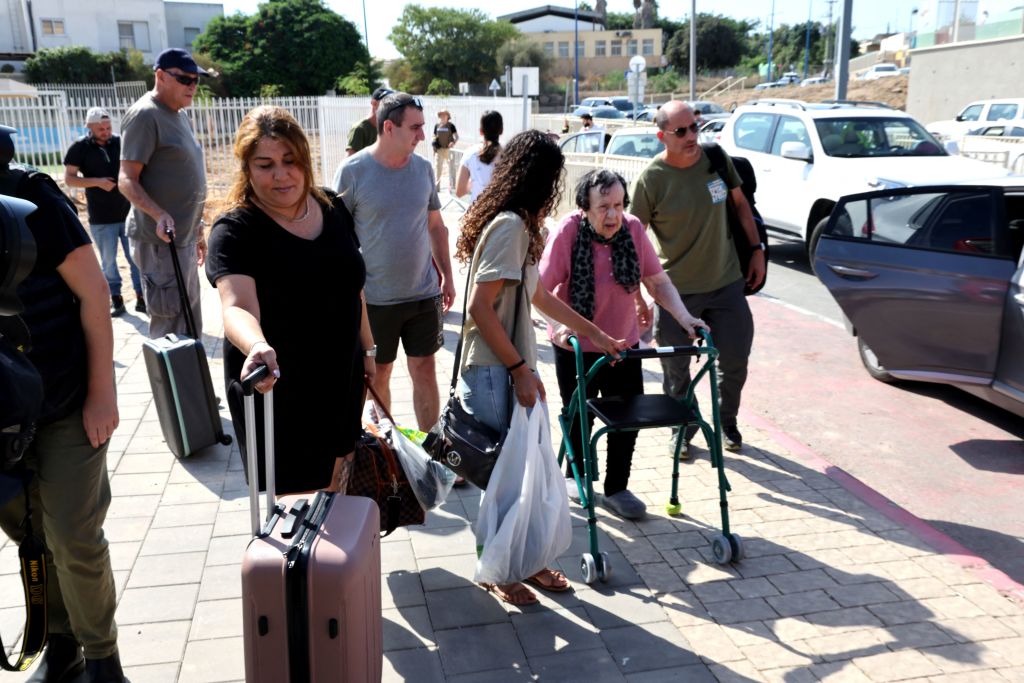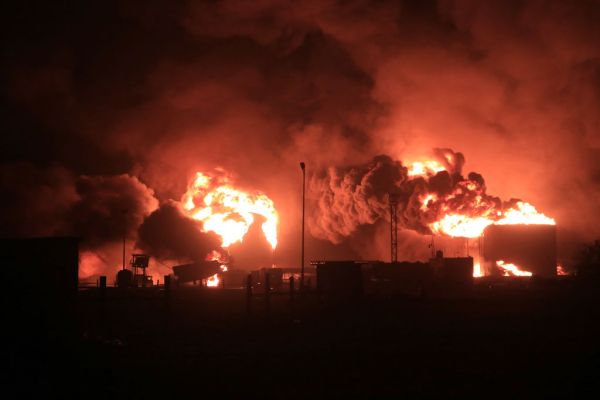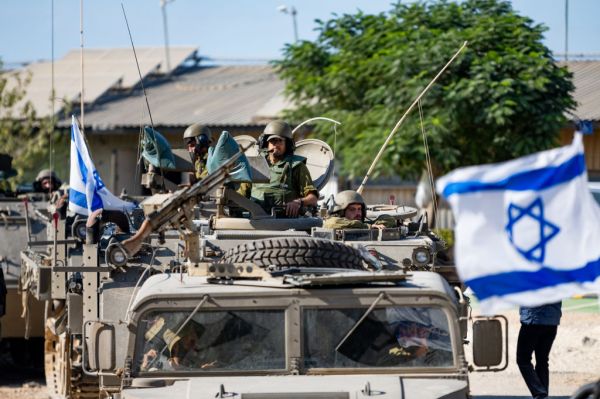NETANYA, Israel—In a hotel basement in the coastal city of Netanya, young children displaced by war play make-believe in makeshift kindergartens. One of their favorite games, despite being largely out of range of Hamas rockets in their new temporary home, is feigning sirens and pretending to run for cover from incoming attacks.
“They’re 2 years old,” said Gila Shalit, the kindergarten’s director. “These are the kind of memories they’re going to grow up with.”
Shalit and other local volunteers hope the kindergarten can give the children a sense of normalcy in a situation that is anything but. For more than two months, the hotel has hosted more than 500 evacuees from Israel’s south and north. The hotel’s inhabitants are among the 250,000 Israelis who are still effectively refugees in their own country—the largest internal displacement in the country’s history—while they wait out a war with no end in sight.
The majority are from the north, where entire cities and towns lining the border with Lebanon sit virtually empty amid ongoing exchanges of fire between the Israeli Defense Forces (IDF) and Hezbollah. In the south, meanwhile, many of the thousands of evacuees from the communities near Gaza have no homes to return to in the wake of Hamas’ attack. While some of the displaced left at the order of the Israeli military, others fled of their own volition, fearing the same fate that befell 1,200 of their murdered countrymen on October 7.
“The main obstacle in rebuilding the communities both in the north and the south is reestablishing a sense of safety,” said Tirael Cohen, the founder and president of Kedma, an Israel-based nonprofit working to strengthen community resilience in border communities across the country. “Houses that were breached on October 7 will not be inhabited until Hamas doesn’t pose a threat, and in the north many fear that Hezbollah will try to reenact the atrocities we saw in the Gaza envelope.”
In other words, two months of displacement could easily extend several more. Hotels across the country are overflowing with refugees of all ages, along with their pets and remaining belongings. Local volunteers have joined forces with municipal governments to provide services to the displaced families, from child care to educational programs for the elderly. In addition to their time, Israelis have donated food, toiletries, winter gear, and other supplies to the refugees—many of whom fled their homes with nothing but the clothes on their backs.
Nonprofit organizations have also mobilized to provide mental health support to the displaced, particularly those from southern communities most affected by Hamas’ massacre. Many of the refugees have family members and friends who were murdered in the initial onslaught, while others are still awaiting the return of kidnapped loved ones from Gaza. “After being in this terrorism event, they were also evacuated from their homes,” Cohen told The Dispatch. “They’re still so profoundly inside of the trauma.”
This is certainly true for Kazak al Kabez, a 63-year-old from the southern city of Sderot whose son was among those killed by terrorists on October 7. After being evacuated from the embattled city by the Israeli military during Hamas’ initial attack, al Kabez was unable to return to her child’s grave site one month after his burial, as is typical according to Jewish custom. Now, she has no sense of when she’ll be able to return home.
“Everyone helps me, but I’m still sad. I can’t be the normal me,” al Kabez said from the hotel in Netanya. “I have a home but I don’t have a home. All of my life I built a home, a place where I can be safe. But now I know that I don’t have that anymore.”
Al Kabez and her neighbors have long lived in the line of rocket fire. But for her and many Israelis, the October 7 invasion shattered the idea that even uncomfortable coexistence with a Hamas-run Gaza can be achieved through diplomatic means. “I can’t make peace with somebody who wants to kill me,” said Lezi Levi, a volunteer with Bonot Alternativa, the group running the kindergarten. “If you want to talk, talk. Don’t shoot.”
“Everyone feels inside of them this conflict, this dissonance. We want to be in our home, but on the other hand we are not safe and the world doesn’t protect us,” Linoy Hagag, another volunteer with Bonot Alternativa and a resident of the southern city of Be’er Sheva, told The Dispatch. “I go to sleep with a knife.”
Meanwhile, evacuees from the north have watched as an increasingly dire situation plays out along the border with Lebanon. The IDF began to urge residents of the north to evacuate as early as October 8, when rocket fire and terrorist infiltrations from southern Lebanon opened a second front in the war. Since then, the army has issued mandatory evacuation orders to some 80,000 Israelis living within 6 miles of the border.
Like Israelis from the south, most of these afflicted families are no strangers to conflict. During the Second Lebanon War in 2006, thousands of Israeli civilians fled the northern border regions to avoid being caught in the crossfire. But the scale and ferocity of the attack out of Gaza came as a shock to residents of the north such as Shay Cohen, causing them to look across their own border at Hezbollah—an Iranian-backed terrorist group with military outposts and fighters on the very edge of Israeli territory—with a renewed sense of horror.
“They took our feeling of security. We don’t feel safe anymore, anywhere,” said Cohen (no relation to Tirael), who fled northern Israel and is now working on behalf of the local government to help families at the Netanya hotel. Prior to October 7, Cohen added, she and many others felt a false sense of security—even as Hezbollah inched closer to the border with Israel. But Hamas’ attack highlighted the imminent danger posed by the Lebanese militants, who boast a bigger fighting force and a larger, more lethal arsenal than their Gazan allies.
“They are more powerful, and they can do something much worse than what Hamas did. They’re waiting for the right time, and I don’t want to be there at the right time,” she said. “If we also have to go to war in Lebanon now, this is what we have to do. Because we can’t have the risk that this will happen again.”
By some accounts, it looks like the Israeli military may be preparing for such a contingency. The Times reported Monday that the IDF had drawn up plans to push Hezbollah forces out of southern Lebanon if they don’t withdraw voluntarily, lending credence to threats made by Israeli leaders in recent weeks.
“If the world doesn’t get Hezbollah away from the border, Israel will do it,” Benny Gantz, a minister in Israel’s war cabinet, said during a visit to the area last week. Earlier this month, Israeli Defense Minister Yoav Gallant informed mayors from northern Israel that their constituents can’t return home until the terrorist group is driven north of Lebanon’s Litani River—some 18 miles from the border between the two countries.
In the meantime, the displaced families are living in a state of limbo.
“It’s very difficult. You don’t have your privacy, you’re staying with people you don’t know. You’re living in one room. And you don’t know how long it’s going to take,” said Anat Yaloz, who evacuated from the border town of Shlomi more than two months ago and has been living at a hotel in the northwestern city of Haifa ever since. “You have no clarity about the future, and you’re scared to go back to your home. Because now we understand that what happened on the 7th of October in the south could happen in the north.”
“All these years, I thought that I was safe,” she added. “I thought that the army was protecting us, and nothing like this could happen. And now we know that this could happen—it could happen to us.”









Please note that we at The Dispatch hold ourselves, our work, and our commenters to a higher standard than other places on the internet. We welcome comments that foster genuine debate or discussion—including comments critical of us or our work—but responses that include ad hominem attacks on fellow Dispatch members or are intended to stoke fear and anger may be moderated.